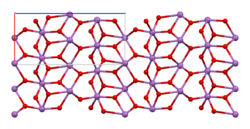 α-Sb2O4 | |
 | |
| Names | |
|---|---|
| IUPAC name antimony(III,V) oxide | |
| Identifiers | |
3D model (JSmol) | |
| ChemSpider | |
| ECHA InfoCard | 100.014.161 |
| EC Number |
|
PubChem CID | |
| UNII | |
CompTox Dashboard (EPA) | |
| |
| |
| Properties | |
| SbO2; Sb2O4 | |
| Molar mass | 153.7588; 307.5176 g/mol |
| Appearance | white solid |
| Density | 6.64 g/cm3 (orthorhombic form) [1] |
| Melting point | >930 °C (1,710 °F; 1,200 K) (decomposes) |
| Boiling point | decomposes |
| insoluble | |
Refractive index (nD) | 2.0 |
| Structure | |
| orthorhombic | |
| Hazards | |
| NFPA 704 (fire diamond) | |
| NIOSH (US health exposure limits): | |
PEL (Permissible) | TWA 0.5 mg/m3 (as Sb) [2] |
REL (Recommended) | TWA 0.5 mg/m3 (as Sb) [2] |
| Related compounds | |
Related compounds | Antimony trioxide Antimony pentoxide |
Except where otherwise noted, data are given for materials in their standard state (at 25 °C [77 °F], 100 kPa). | |
Antimony tetroxide is an inorganic compound with the formula Sb2O4. This material, which exists as the mineral cervantite, [3] is white but reversibly yellows upon heating. The material, with empirical formula SbO2, is called antimony tetroxide to signify the presence of two kinds of Sb centers. [4]

